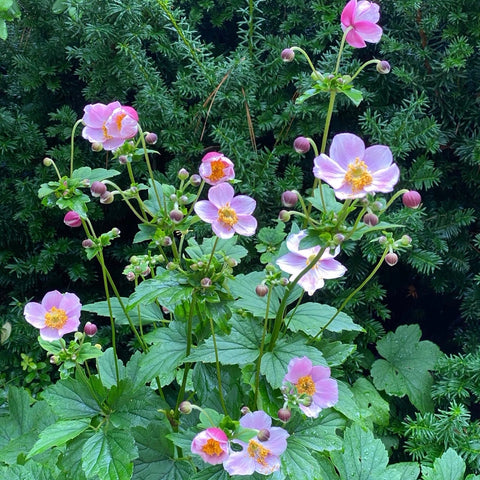As the end of summer nears, the glorious colors of the July garden fade and many of our favorite plants no longer flower. However, have no fear – late blooming perennials to the rescue! Their eye-catching colors unfold throughout the late season and these late bloomers also provide structure to your beds and contrast to the brilliant hues of the early and mid-summer garden.
Tall Joe Pie weed (Eupatorium “Gateway” or “Riesenschirm”) is a terrific late bloomer at the back of the border and, just when we think the final garden notes have been played, native purple Ironweed Vernonia noveboracensis and its more compact cultivar, “Iron Butterfly”, offer stunning displays of fireworks. The tall yellow blooms of Native Wingstem (“Verbesina Alternifolia”) make for perfect late companion plantings as well.
At the front of the border, late blooming aster will extend a warm welcome and, earlier in the season, they are sometimes mistaken for well-maintained evergreens, although they require no trimming at all. Hardy perennial mums provide lush green foliage long before they flower and many fall blooming salvia do the same – in fact, some salvia will continue to provide color until the first heavy frost. And, let’s not forget those marvelous dahlias of the late season – how truly wonderful they are! Another dual-purpose perennial is “Arkansas Amsonia” (A. hubrechtii) as, early in the season, it presents light blue flowers at the end of its needle-like stems while its main attraction is actually its finely textured foliage. Then, in the fall, this plant turns bright gold with occasional hints of orange – a new variety, “Butterscotch”, has bright reddish stems, and I hear it will soon be available.

Aster oblongifolius

Dahlia "Debora Renae"
Just about every garden benefits from the inclusion of ornamental grasses, such as fountain grasses – they begin their bloom in mid-August and later transform first into brown, then into golden, mounds through much of the winter. Try to find some of the newer fountain grass varieties, if possible, as they don’t produce seeds. Tall moor grass, “Molinia”, with its veil-like effect, is another fantastic late season plant -- it’s best planted in relatively sparse tufts interspersed throughout other plantings and when the first frosts arrive, its leaves and stems become fountains of bright gold. If you can’t live without Miscanthus, I recommend a very late blooming variety which doesn’t produce seeds such as “Morning Light” or Miscanthus “Arabesque”.
And now for the shade garden. Japanese Anemones are a lovely accent here -- try the reliable earlier blooming A. tomentosa “Robustissima” or choose varieties of A. hupehensis as well as A. japonica and many of its hybrids. The hardiest of the later blooming varieties is tall white A. “Honorine Jobert” as some of the double flowered and more compact cultivars are not always reliable. We are expecting newer and hardier varieties to arrive soon so ask your favorite garden center about these – in particular, keep an eye out for the “Swan Series”. And take note that it’s best to plant your fall blooming anemones early in the season as they may not come back if planted late. One more shade loving plant to consider is the toad lily -- its lovely flowers will really brighten up this section of the garden.

Anemone tomentosa "Robustissima"
If you decide not to continue deadheading your perennials in the late season, many of them will display striking seedheads so experiment a bit and see if you like the look. Here, at LongHouse, you will see some examples of this and we look forward to sharing our vast variety of plantings and magnificent collection of sculpture when next you visit. Just reserve your tickets at www.longhouse.org and happy late season gardening!

Colchicum autumnale

Tricytris hirta
